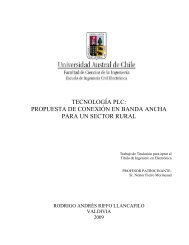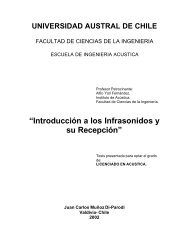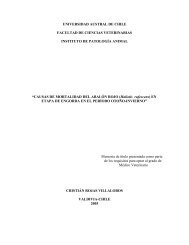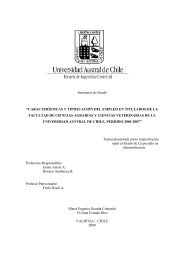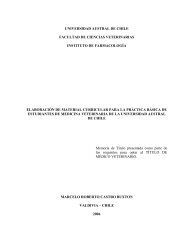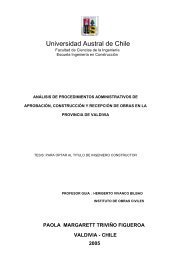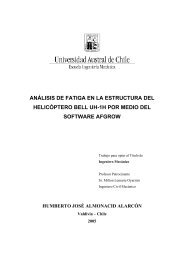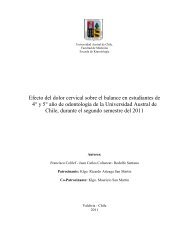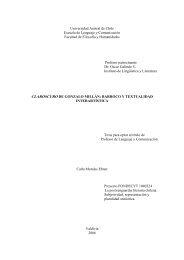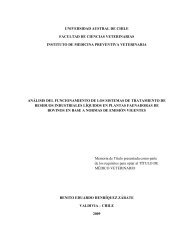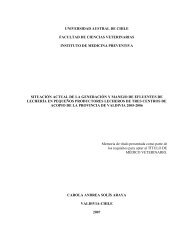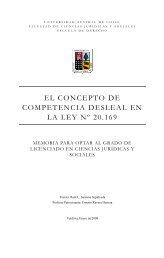Diversidad y control biológico de insectos - CyberTesis UACh ...
Diversidad y control biológico de insectos - CyberTesis UACh ...
Diversidad y control biológico de insectos - CyberTesis UACh ...
Create successful ePaper yourself
Turn your PDF publications into a flip-book with our unique Google optimized e-Paper software.
fields that are sprayed with pestici<strong>de</strong>s such as lambda-cyhalothrin often have lower spi<strong>de</strong>r<br />
populations (Wehling and Heimbach, 1991; Maloney, 2002), as a consequence of the high<br />
spi<strong>de</strong>r susceptibility to this kind of insectici<strong>de</strong> (Krause et al., 1993).<br />
Lycosid spi<strong>de</strong>rs prey on lepidopteran pests in several crops: corn (Laub and Luna, 1992),<br />
rice (Wilby et al., 2005), soybean (Pearce et al., 2004), apple orchards (Allen and Hagley,<br />
1989). Although the diet of spi<strong>de</strong>rs in the Chilean pastures is unknown, top-down effects of<br />
spi<strong>de</strong>rs are evi<strong>de</strong>nt even when they do not actually feed upon the target pest (Greenstone,<br />
1999). Often, insect herbivores reduce their feeding when in the presence of spi<strong>de</strong>rs, and<br />
disperse or abandon high quality patches (Sun<strong>de</strong>rland, 1999). It has been stressed that an<br />
assemblage of spi<strong>de</strong>r species is more effective at reducing prey <strong>de</strong>nsities than a single<br />
species of spi<strong>de</strong>r (Greenstone, 1999; Sun<strong>de</strong>rland, 1999). As suggested by Greenstone<br />
(1999), it is important to have an assemblage of spi<strong>de</strong>rs rather than just one species so<br />
predators of appropriate size classes and foraging mo<strong>de</strong>s will be present to prey upon<br />
different prey life stages throughout the growing season. Therefore, it would be <strong>de</strong>sirable<br />
for growers to have a more selective tool than lambda-cyhalothrin if conservation of spi<strong>de</strong>r<br />
assemblage is attempted.<br />
In<strong>de</strong>ed, it seems that spi<strong>de</strong>r species abundant in pastures (agrobionts and agrophiles) are not<br />
the same present in surroundings (Martin and Major, 2001; Al<strong>de</strong>rweireldt, 1989).<br />
Therefore, edges would not be primary migrant sources for the agrobionts and agrophiles<br />
spi<strong>de</strong>r species, making more difficult for local populations recovering from <strong>de</strong>pressed<br />
levels caused by insectici<strong>de</strong> spraying. Lycosid spi<strong>de</strong>rs migrate basically by cursorial<br />
movement (Bishop and Riechert, 1990). Ballooning, the colonization mean over long<br />
distances, is possible just for juveniles less than 5 mm (Pearce et al., 2004; Bell et al.,<br />
2001), then the capacity of spi<strong>de</strong>rs to recolonize areas where they were removed is limited<br />
over long distances. Therefore, to avoid spi<strong>de</strong>r local extinctions in pastures is highly<br />
<strong>de</strong>sirable and this can be accomplished if, for instance, lambda-cyhalothrin spraying is<br />
restricted to crucial periods in the pest life cycle, spraying at midday when many wan<strong>de</strong>ring<br />
spi<strong>de</strong>rs are inactive and in sheltered location (Riechert and Lockley, 1984) or preferring<br />
other less disruptive tools such as the B. bassiana spores tested in this study.<br />
In small-scale within-field trials, the impact of pestici<strong>de</strong>s may be un<strong>de</strong>restimated (Duffield<br />
and Aesbicher, 1994; Prasifka et al., 2005), because individuals can migrate from the<br />
62



